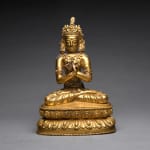Sino-Tibetan Figure of Vajradhara, 1500 CE - 1600 CE
Gilt-Bronze
height 19.6 cm
height 7 3/4 in
height 7 3/4 in
CB.2894
Further images
This is a gilt-bronze sculpture of Vajradhara. He assumes a crowned and jewelled appearance, wearing earrings, wristbands and a necklace. He holds two vajra sceptres in his hands, crossing each...
This is a gilt-bronze sculpture of Vajradhara. He assumes a crowned and jewelled appearance, wearing earrings, wristbands and a necklace. He holds two vajra sceptres in his hands, crossing each other in front of his chest. He has a peaceful smile on his face, along with his gentle elongated eyes. The dhoti on his lower body is particularly well adorned, as reflected by the beads worn on his legs. The slim torso with cinched waist and slender hips is reminiscent of earlier, Pala prototypes which constituted the primary influence for sculptural styles in Nepal and Tibet.
Vajradhara is the primordial buddha, as well as the personification of the dharmakaya - truth body of enlightenment and progenitor of the Vajrayana system of Buddhism. He represents the essence of the historical Buddha’s realization of enlightenment. This also explains the fundament of his iconography – that he is holding the manifestations of the two aspects of dharma in hands. The vajra sceptre symbolises the strength of the dharma, that it is invincible and the mightiest. The bell symbolises the compassion to spread the dharma, that it should be heard by every sentient beings and thus guiding them to Buddhahood. His mantra – om ah Guru Vajradhara hum! – pays obeisance to the one who embodies the highest level of Enlightenment.
Reference: Sotheby's, New York, 22 Mar 2018, Lot 1038 & 104
Danny Ching
Vajradhara is the primordial buddha, as well as the personification of the dharmakaya - truth body of enlightenment and progenitor of the Vajrayana system of Buddhism. He represents the essence of the historical Buddha’s realization of enlightenment. This also explains the fundament of his iconography – that he is holding the manifestations of the two aspects of dharma in hands. The vajra sceptre symbolises the strength of the dharma, that it is invincible and the mightiest. The bell symbolises the compassion to spread the dharma, that it should be heard by every sentient beings and thus guiding them to Buddhahood. His mantra – om ah Guru Vajradhara hum! – pays obeisance to the one who embodies the highest level of Enlightenment.
Reference: Sotheby's, New York, 22 Mar 2018, Lot 1038 & 104
Danny Ching









